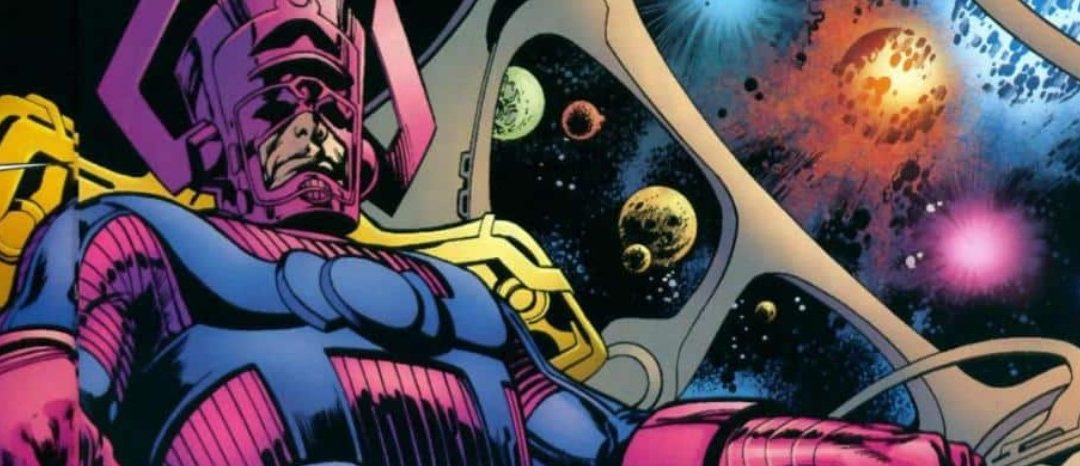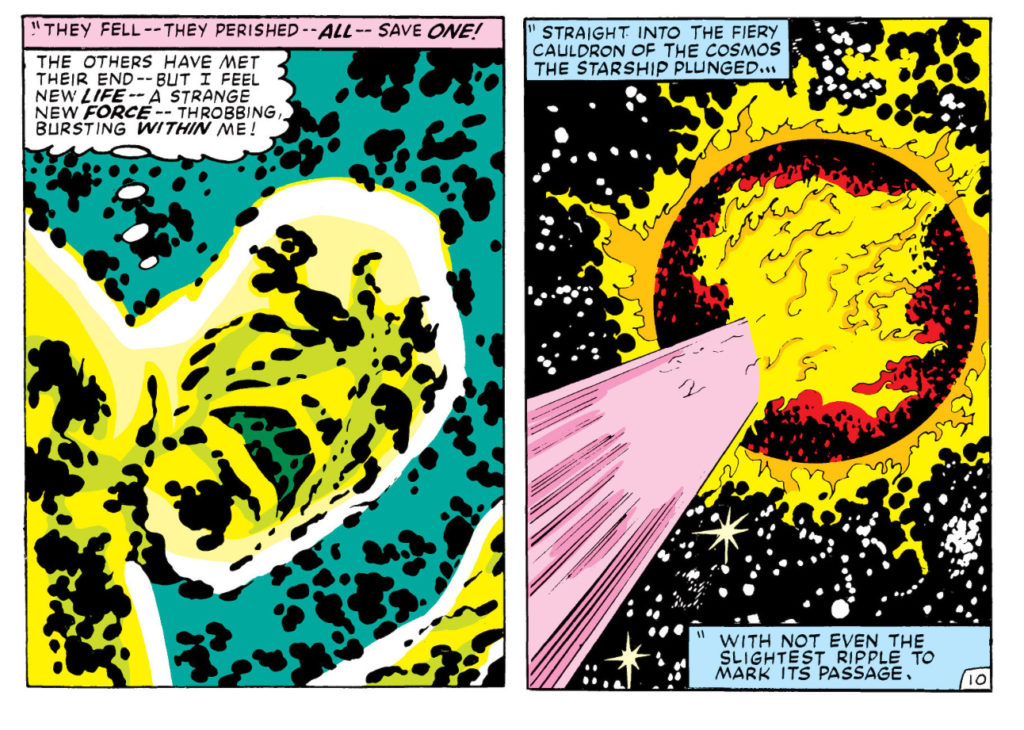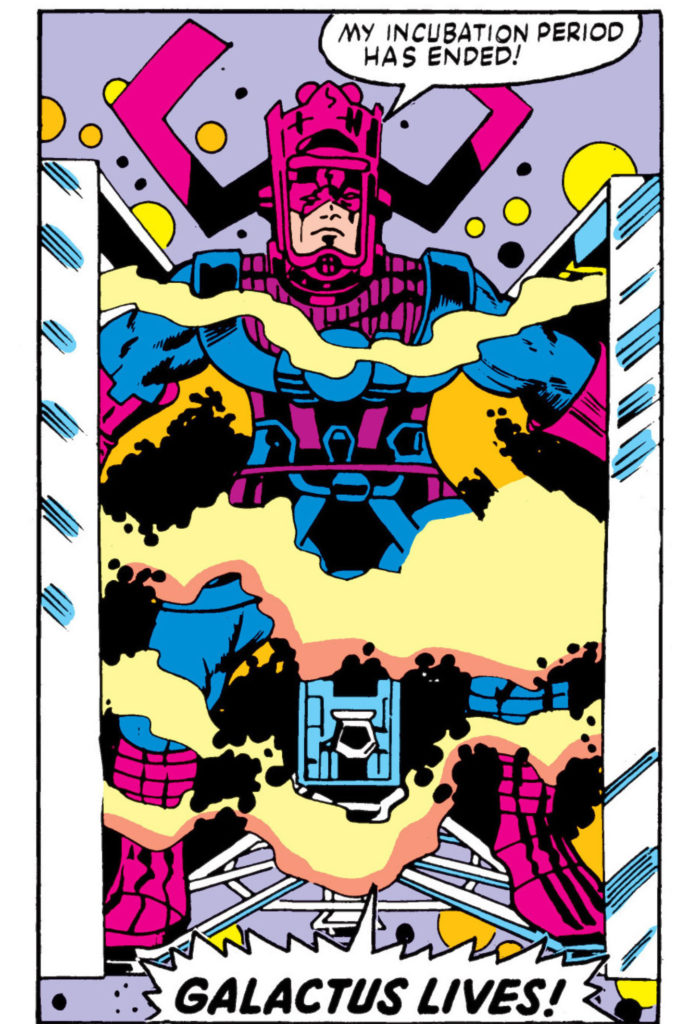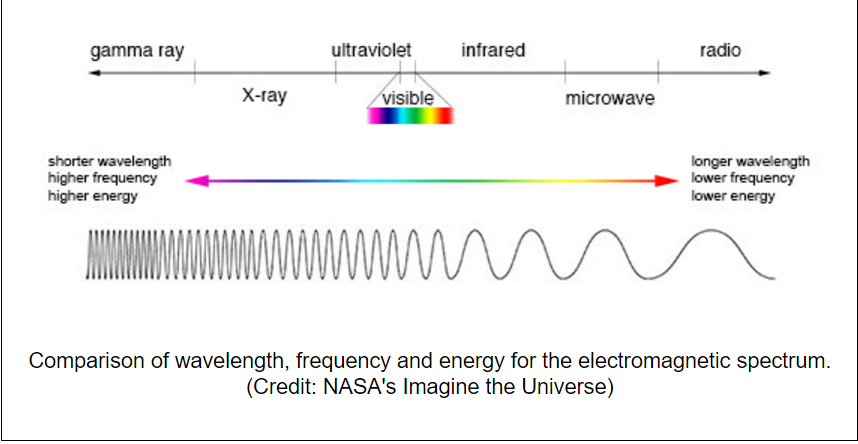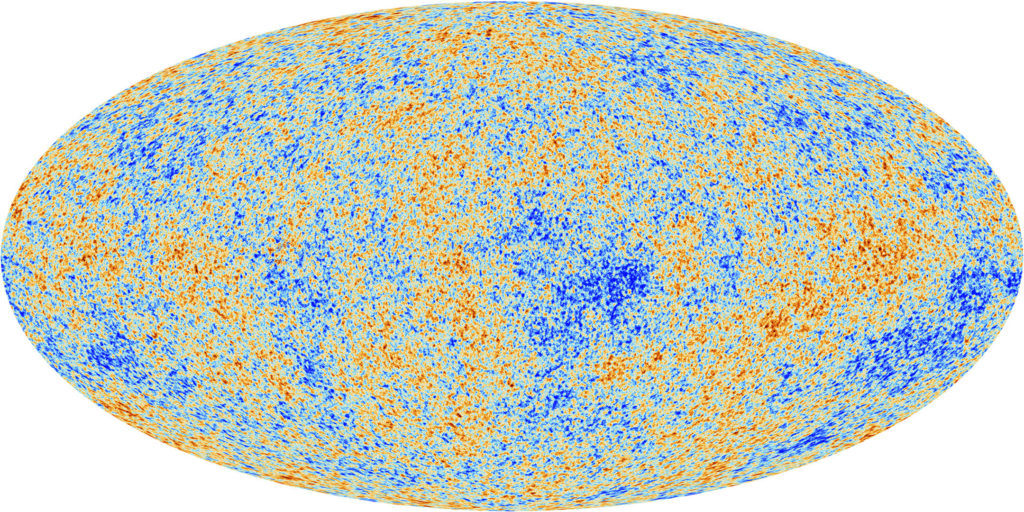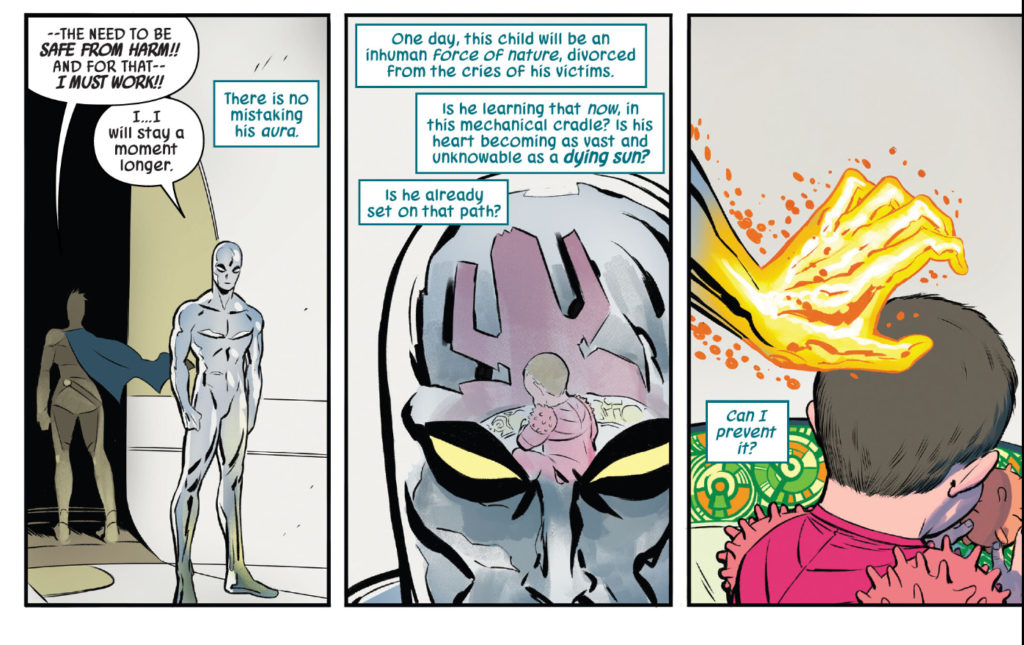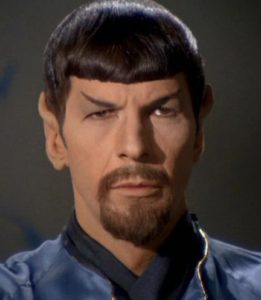Galactus.
The fact that you read that name and don’t get a knot in your stomach is one reason you know you’re living in “our” universe rather than the Marvel Universe.
The other way you know that you’re not living in the Marvel Universe?
Our universe. Literally. It doesn’t work with the big guy’s origin.
Let’s make sure we’re all up to speed here.
GALACTUS 101
First appearing in Fantastic Four #48 (1966, by Stan Lee and Jack Kirby), Galactus has been a constant in the Marvel Universe for nearly 50 years. But Galactus wasn’t born in the “current” Marvel Universe. Instead, as his origin explains, Galen of Taa comes from the universe that preceded ours.
A little bit of Marvel Universe 101: the current Marvel Universe is the “Eighth Cosmos,” or the eighth iteration of reality. The present cosmos is a nearly identical copy of the Seventh Cosmos, which was destroyed at the start of Secret Wars (2015). In 2021’s Defenders limited series, creators Al Ewing and Javier Rodriguez took a disparate group of heroes backward through the previous Cosmoses to stop at the Third before ending their adventure. Each previous Cosmos was more primal and more…trippy. Nevertheless, it was a great story, and its sequel, Defenders Beyond, explains the Second Cosmos and beyond.
Back to Galen – he was a scientist and explorer, obsessed with finding a solution for the wave of death that was killing off all the life in the universe. While seeking answers in space, Galen and his ship are pulled into what seems to be a Big Crunch, the theorized opposite number of a Big Bang. “Inside” the Crunch, Galen bonds with the Sentience of the Universe and survives. As a result, Galan has VIP seating for the Big Bang that starts the Marvel Universe (the Eighth Cosmos). With some aiding and abetting by the Watcher, Galen gestated inside an “egg” made from the remains of his ship for a few billion years, finally debuting as Galactus. From there, he started eating planets.
There’s more to Galactus’ story than that, but that’s for another day. Instead, let’s look at that origin with our cosmologist hats on.
Galactus’ story involves a specific cosmology model we don’t see in our universe. For over 50 years, data has suggested that our universe started with a “hot” Big Bang. The Big Bang was followed by Cosmic Inflation. Since then, the universe has expanded and cooled.
In Galactus’ experience, the universe is cyclic — born from a Big Bang and expanding for billions of years, but at some point, the expansion slows, stops, and reverses. Finally, all matter and energy are pulled back towards all other matter faster and faster, resulting in a singularity. That singularity is the point from which the “Big Bang” kickstarts the next universe begins. And the cycle repeats.
Cosmologically, there are all sorts of implications that go with a cyclic universe, and each could make for its own article, but as our understanding of such things stands, ours is not a cyclic universe. And it all comes down to the evidence.
We know the Big Bang and cosmic Inflation happened.
THE BIG BANG.
Since the work of Edwin Hubble in 1929, we’ve known the universe is expanding. Hubble’s research showed that the light from virtually all stars in the universe is a little redder than it should be. Redshift is a sign that the objects making the light (the stars) are moving away from us, and as a result, the wavelengths of light we see are stretched.
This stretching and changing what we experience is the same Doppler Effect you hear when an ambulance goes by – as it comes toward you, the siren is higher pitched, but as it moves away from you, it’s lower pitched. The sound waves are stretched as their source (the ambulance) moves away, which decreases the number of waves that reach your ear per second (the frequency): lower frequency, lower pitch.
It’s the same with light or anything traveling as a wave.
Starting in the 1990s, the Hubble Space Telescope saw the redshift of the stars but could see more. The stars were moving away from us, and their velocity was increasing. The universe was expanding, and the rate of acceleration was increasing. By the time you’re done reading this article, stars moving away from us will be moving faster than when you started reading it.
Side note: stars and galaxies aren’t moving away from “us,” specifically. Everything is moving away from everything. Space itself is expanding. The light traveling through space has to travel through more space – same light, larger volume, the wavelength stretches.
Another side note: the galaxies near ours aren’t moving away from us. While gravity holds the stars of the Milky Way, Andromeda, and a bunch of smaller nearby together, it also holds our local group together. So we all move together more or less as a unit.
While you can run the expansion information forward in time to a far future of cold, dark skies and the death of the universe, we want to run it backward.
Wind back the clock on an expanding universe, and you end up with a smaller and smaller universe, “ending” (er, beginning) at a small, super-hot, super-dense spot that contains all the matter and energy. That’s when the Big Bang happened, around 13.8 billion years ago.
Before that, there was just spacetime and energy. But the energy wasn’t an even, flat, calm pool. There were fluctuations – quantum ripples. Imperfections. One day, one of the fluctuations expanded. Fast. Everything in that small spot, even the fluctuations, spread quickly. Faster than light. Cosmic Inflation.
In a super simple version, the energy changed into matter. Then, over a period of time, matter, pulled together by gravity, begins to clump along the former fluctuations — which also stretched. Give it more time, and enough matter collects, falls in on itself, and ignites, birthing the universe’s first stars. In areas with a lot of matter, galaxies form. Let that clock run forward about nine billion years, and a collection of gas and dust in a rather ordinary galaxy gets busy making a sun and a solar system. We call that spot home.
This all sounds like a cool story — conveniently cool to some — but with the 2009 launch of the Planck Telescope, the story got a lot more real.
Planck looked at the universe, over and over and over, looking at the temperature and its variations. The idea was simple — if the universe were once a small, hot clump of matter that expanded quickly to form what we see today, that heat would still be around. Not as what we think of as “heat,” but energy. Ancient energy that’s cooled and cooled. Think of it as being able to tell that your stove was on by looking at the burners with a thermal camera. The burners are no longer red (visible light), but you can still see some energy (infrared – “heat”).
Planck’s image complemented and refined the “WMAP” image from NASA’s Wilkinson Microwave Anisotropy Probe, which had been collecting similar data since 2001.
In glorious detail, the image from Planck shows the cosmic microwave background radiation (CMBR). The heat of the early universe has cooled to the point that it’s not “heat” as we think of it but a form of energy with longer wavelengths and a lower frequency – microwaves.
The image often throws viewers because of its oval shape. In reality, the CMBR image is a 360-degree view of the entire universe from Planck’s point of view. And to fully grasp the idea, think of it in 3D. You’re viewing it, but also, you’re in it.
Take a minute if you need to.
The image’s color variations show tiny temperature differences – places where the universe is just a little “warmer” or “cooler.” The thing about those variations – those are afterimages — stretched and cooled — of the quantum fluctuations of the pre-Big Bang universe. Moreover, the fluctuations in the CMBR match where we see the largest collections of matter in the universe.
Cosmic Inflation is a model to predict what the universe should be like. Observations have matched the model.
Long story short, that’s the broad strokes of how we know the Big Bang happened and the cosmos just before the Big Bang. And given that the universe’s expansion is speeding up, the evidence points to the theory that everything will keep expanding, ultimately cooling and dying. That’s the heat death of the universe.
Inflation also allows for a multiverse in a variety of ways.
OTHER CONTENDERS
Given the evidence that has piled up over the years, our universe doesn’t appear to support the origin of Galactus. For that, you’d need an alternate theory. There are three main contenders, two of which could theoretically support Galactus: Big Bounce and Conformal Cyclic Cosmology.
Both theories are born of their proponents’ dissatisfaction with Cosmic Inflation and claim to offer a more straightforward explanation of the Big Bang and the universe’s history. Your mileage may vary, of course.
Of the two, the Big Bounce is the simplest to understand. After an indeterminate period of expansion, the universe begins to contract – the Big Crunch mentioned earlier. Everything collects into a super-hot, super-dense point. From there, the universe would “bounce” in a Big Bang.
The Big Bounce theory suggests that time has no beginning and no end. Our perception of all reality is just this period, in this particular cosmos. Ultimately, it will collapse, starting another, and this cycle will happen forever. Literally forever.
Putting Galactus into this model is easy — the “Seventh Cosmos” of the Marvel Universe was just the universe before ours that collapsed. The Eighth is just the new universe after the bounce.
The other idea that supports Galactus, Conformal Cyclic Cosmology (CCC), follows a similar theme but is slightly different.
First suggested and promoted by Nobel Laureate Roger Penrose in his 2010 book, Cycles of Time: An Extraordinary New View of the Universe, the idea is a deep dive into cosmology and quantum mechanics but does have some relatively easy-to-grasp (but still weird) main points.
The history of the cosmos breaks into what Penrose calls eons – marked by a Big Bang and then expansion. At some point, the universe will expand to its maximum size, cooling as it does. Along the way, all matter will be pulled into black holes. The black holes will continue to cool and boil away via Hawking Radiation.
Except for photons. This makes a cold, dead universe look like the Big Bang model for the universe. A new Big Bang will kick up from this state, starting another Penrose’s eons.
In CCC, Penrose explains, there would be “leftovers” of the universe previous to ours, observable in the CMBR, “bruises” in the CMBR left by the final evaporation of black holes during the last eon. Penrose calls these “Hawking Points.”
These signals – the Hawking Points – are where things get ugly. Working with researchers around the globe, Penrose insists they can be observed. However, many astrophysicists claim Hawking Points can’t be seen with a standard interpretation of the data from the CMBR. You can see Penrose’s “Hawking Points” if you look at the data while — metaphorically — squinting, cocking your head at a specific angle, and humming a middle C note while exhaling.
The more technical term is that Penrose’s results come from an analysis of the data “in a scientifically unsound and illegitimate fashion,” according to astrophysicist Ethan Siegel.
The third contender for the universe’s origin involves the creation of a “Mirror Universe,” and that’s something for another day.
NO HOME FOR GALACTUS
The idea of a hot Big Bang followed by Cosmic Inflation has stood up to challenges for years. More than that, research provides more data that supports the theory. As evidence has piled up in favor of the idea, the hot Big Bang followed by Cosmic Inflation has moved from one of a field of contenders to explain our universe to the top of the stack, the spot from where future science will start. It’s the best model we have, the one that the data supports.
Changing an accepted theory is simple: just bring the evidence. That’s all. Just show evidence that other researchers can view, independently reproduce and reach the same conclusion.
There are still holes in the Big Bang theory, and there will always be holes. We’ll never be able to directly observe the Big Bang itself, no matter how good our tools are. The superheated plasma just after the Big Bang is opaque. The best we can do is look at the universe’s evidence and develop theories that match observations.
That’s how science works. Theories either solidify or change as new data comes to light. The data supports a hot Big Bang followed by Cosmic Inflation, with no connections to former (or future) universes. We’re bound to learn more as we go, but in the end, all we can do is follow the universe’s lead.
And for our universe, that means no Galactus.
Sorry, big guy.


